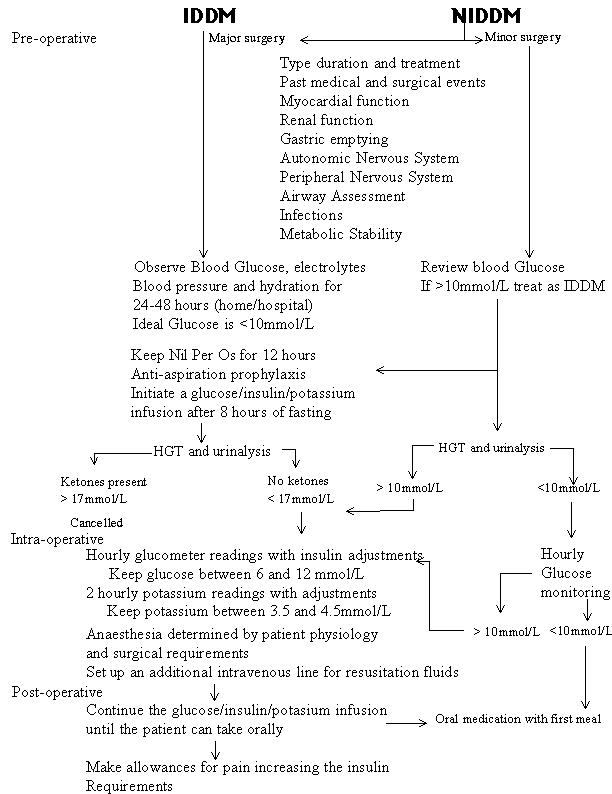
History to determine effort tolerance, clinical examination for cardiac failure and an
electrocardiogram in all patients. Echocardiography can help in assessing an ejection
fraction in borderline cases
Renal
Urea and electrolyte determination.
Dipstix urinalysis for proteinuria
Gastrointestinal
Gastroparesis - History of eary satiety and reflux
Nervous System
History of postural dizziness, post gustatory sweating, noctural diarrhoea and impotence.
Careful documentation of peripheral sensation.
Small Joint Disease
Clinical assessment of neck extension, examination of the small joints of the hand and a good evaluation of the ease of intubation.
Ophthalmology
Cataracts, glaucoma and retinopathy will decrease visual acuity and increase the
unpleasantness of the perio-operative period. Increase the amount of explanation and
reassurance to the patient.
Evidence of overt infectious disease
A chest X ray is often warrented to search for occult tuberculosis.
Take careful note of the central nervous system and the head and neck.
Metabolic Control
Hypoglycaemia
The diabetic patient is at an increased risk for peri-operative hypoglycaemia.
Hyperglycaemia
Glucagon, cortisol and adrenaline secretion as part of the neuroendocrine
response to trauma will increase in proportion to the magnitude of the stress. During
major catabolic insults are associated with a severe hyperglycaemia which can cause
Osmotic diuresis, making volume status difficult to determine and risking profound
dehydration and organ hypoperfusion
Hyperosmolality with hyperviscocity, thrombogenesis and cerebral oedema
Keto-acidosis
Any patient who is in a severe catabolic state and has an insulin deficiency (absolute or
relative) can decompensate into keto-acidosis
Electrolyte abnormalities
Anticipate imbalances in potassium, magnesium and phosphate
Protein catabolism and impaired polymorphonuclear phagocytic function
Proteolysis and decreased amino acid transport retards wound healing. Loss of phagocytic
function increases the risks of post-operative infection.
Specific Peri-Operative Management
Choice of Anaesthetic
Surgical requirements and the patients physiological status dictate the primary
anaesthetic. Regional anaesthesia has the advantages of attenuating the neuroendocrine
response to surgery and having an awake responsive patients who can report symptoms
promptly. A thorough neurlogical examination is mandatory to document the degree of
peripheral neuropathy present.
Fluid Replacement
Ringer's Lactate has 28mmol/L of the gluconeogenic substrate lactate present and blood
will have various amounts depending on the degree of storage. Massive infusion of Ringer's
and blood will complicate blood glucose control.
Diabetic Keto-acidosis
Diabetics with infections will all have some degree of dehydration,
hyperglycaemia, acidosis and hypovolaemia present. Medical management of these patients is
not possible without removal of the infection. When aggressive resuscitation with fluid,
insulin and potasium has made some improvement of the metabolic condition, anaesthesia can
be started. With the removal of the source of infection the fluid, insulin and potasium
requirements are often markedly decreased, so these patients must have close
post-operative monitoring as well.
Glucose / Insulin / Potasium Infusion
There are numerous different regimens recommended for diabetes, the pricinpals
are all the same and the actual implementation will depend on the facilities available
Infuse Insulin.
Infuse Glucose at 0.1g/kg/hr.
Infuse Potasium along with the glucose and insulin
Insulin Units per hour |
Potasium mmol/L |
|||
HGT mmol/L |
Insulin U/100ml |
< 3.5 |
3.5-4.5 |
>4.5 |
5 |
1 |
mmol / 100ml |
||
5-10 |
2 |
1.5 |
1 |
0.5 |
10-20 |
3 |
3 |
2 |
1 |
20 |
4 |
4.5 |
3 |
1.5 |
>20 |
5+ |
6 |
4 |
2 |
Summary of Management

| Date of First Publication: 2000 | Date of Last Update: 2006/10/24 | Web page author: Click here |